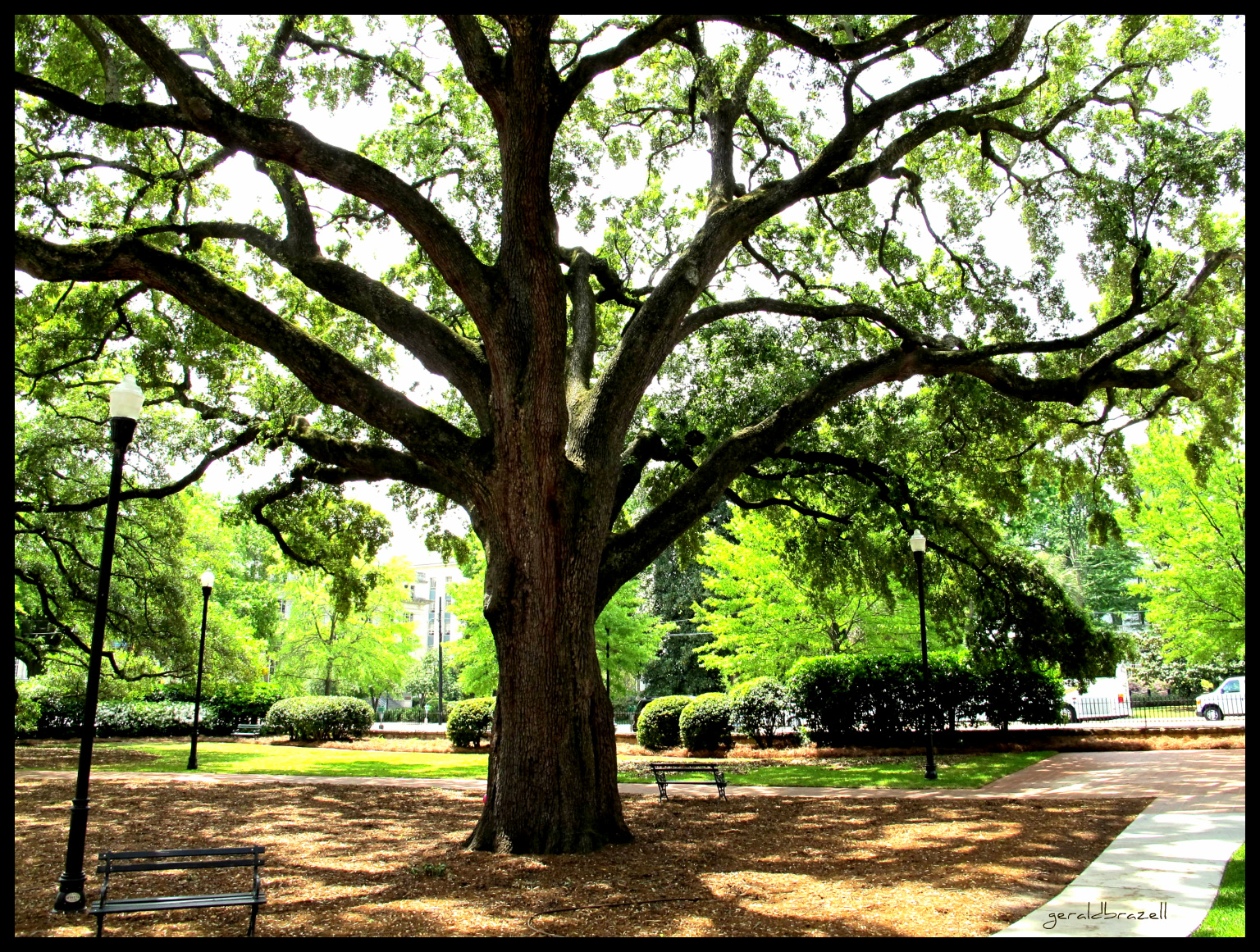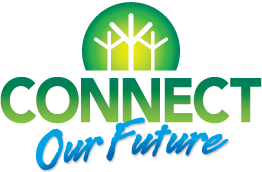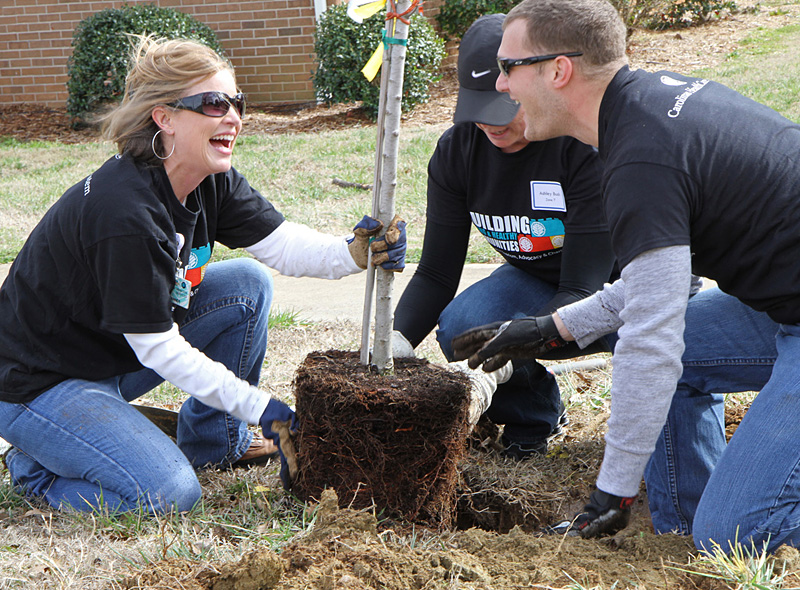Trees in and around cities provide a range of benefits to the city and human health, such as maintaining or enhancing a better environment (air, water, soil, etc.) and enhancing the visual character of a place. The preservation of existing trees and the planting of new trees is an important element of enhancing urban and rural communities’ quality of life. The “green” character so valued by many communities in the CONNECT region is largely due to tree canopy.
Why is this important to your community?
Beyond their physical beauty and contribution to community character, trees provide a multitude of benefits to the natural environment and human populations. Trees contribute to a healthy atmosphere, make air safer to breath, reduce erosion, and are a key component in the regional green infrastructure and open space network. Despite their value, the fate of trees is constantly threatened by both manmade and natural influences. New development—both greenfield and infill—often results in the clearing of trees—whether it is large swaths of forest to make room for a new residential community or commercial development, or the loss of single trees in infill where a greater amount of the site is occupied. Trees may be also taken down in storm events, such as ice storms and hurricanes, or by pests, such as cankerworm infestations. In recent years, many cities and towns have been creating tools and programs designed to care for, maintain, and restore tree canopy and protect the urban forest, ranging from regulatory codes, to community organizations whose mission is to advocate for and plant additional trees.
Where is it appropriate to use?
What priorities does it address?
What other tools are related?
How does it work?
Preserving tree canopy usually is not one quick fix, but involves the overlapping of several tools and community advocates. Cities may choose to create an Urban Forest/Tree Canopy Management Plan that focuses on tree preservation and maintenance in urban areas and their surroundings. This usually involves an inventory of existing trees and tree coverage. Some cities have dedicated staff positions or advisory boards for monitoring tree preservation activity, with dedicated budgetary funds. Outside of the regulatory realm, nonprofits and community groups can also make a big difference. Many community groups serve as local policy advocates for maintaining tree canopy and lobbying for more stringent local protection of trees, and their incorporation into standards for new development. Additionally these groups organize community events such as tree plantings and maintenance days for volunteer groups and children, educate the public about the value of trees, and raise awareness for the advancement of tree protection programs. Nationally, several organizations provide resources and standards for tree preservation such as Arbor Day’s Tree USA program and American Forests.org.
Ready to get started?
Using the Tool
Preserving tree canopy typically involves a combination of various tools and options. Some cities have some of these mechanisms in place, while others need more robust strategies. Ideally, a comprehensive tree canopy preservation program will include:- A tree canopy survey or management plan. Prior to the establishment of any programs or ordinances, a city or town should undertake a tree canopy survey, inventorying the number and quality of trees, and distinct categories of tree types and species. This process would also enable the community to come together to articulate its goals for tree canopy preservation, street trees, and helps encourage the support of public officials.
- A tree preservation ordinance. This is the strongest tool that a city can have to maintain and restore its tree canopy. There is no one way to write a tree preservation ordinance, but they provide guidelines for the removal of trees and their replacement if removed as a result of new development. Ordinances are most successful for reducing clear-cutting, maintaining tree canopy, requiring adequate landscaping of new development, and protecting trees of local significance. In North Carolina, it may be necessary to obtain local legislation from the state’s General Assembly to be able to adopt local ordinances. In some instances, homeowners associations may be able to implement tree preservation requirements within their neighborhood or subdivision covenants and restrictions.
- A tree preservation advocacy nonprofit or collaborative. Appreciation of trees is a universally-shared community value. Many cities and towns have nonprofits or advocacy groups focused on tree preservation, community building, enhancement of the physical environment, and education of the benefits of urban trees. If a grassroots, community-based organization does not already exist, one may be established with city oversight, or the city or town could support or endorse an existing group. These groups are important for serving as a community liaison, providing opportunities for tree plantings and bandings, maintenance and community beautification and to provide an unwavering policy advocate for tree protection.
- Designation as Tree City USA. The Arbor Day Foundation has created the Tree City USA program which upholds standards for cities to achieve status as cities with reputable tree canopies. To qualify as a Tree City USA community, a town or city must meet four standards:
Partners
- Advocacy Groups
- Colleges and Universities
- Community Development Organizations
- Construction Companies
- Departments of Education / School Districts
- Developers
- Elected Officials
- Housing Authorities
Where has it worked?
Trees Charlotte - Charlotte, NC
About the Program
TreesCharlotte is a public/private collaborative dedicated to increasing civic awareness, education and engagement in the environment by preserving Charlotte’s tree canopy—one of its signature natural resources. In pursuit of its mission to grow the tree canopy to 50% coverage by 2050, TreesCharlotte’s goal is to plant 15,000 trees annually, primarily with volunteers. TreesCharlotte was founded after a Knight Foundation grant convened a Canopy Committee and aerial analysis in 2008 to survey the loss of tree canopy in the city. Today the organization is incubated at Foundation for the Carolinas, has a full-time executive director and a Foundation Board consisting of key city leaders, officials, and business owners. TreesCharlotte grows yearly through the support of donors, partnerships, and robust fundraising.
Why it works
Though a fairly new organization, TreesCharlotte has proven successful due its process-rich development process and endorsement by City Council. The foundation of the organization was a result of proactive action by Charlotte’s leadership entities and community leaders, rather than a purely grassroots effort, which is how many other such organizations may be established. The goal of preserving tree canopy is endorsed by City Council and led to the formation of the organization. TreesCharlotte hosts a well-designed website with an updated calendar of community events and resources for tree education and opportunities for support. TreesCharlotte focuses programs around three core values: community vitality, education and the environment. These core values provide the framework for the organization’s educational events and advocacy platforms.
Comprehensive Landscape Ordinance - Columbia, SC
 Image Source: geraldbrazell. Source License: CC BY-ND 2.0.
Image Source: geraldbrazell. Source License: CC BY-ND 2.0.
Contact
Sara Hollar, Superintendent
803-545-3860
forestry@columbiasc.netAbout the Program
Columbia, South Carolina has a comprehensive landscape ordinance within its development code that includes a variety of categories that affect tree canopy: street trees, landscaping, tree protection, and timber harvesting. It applies to trees on public and private property, excluding single-family detached residences and utilities, and to new and retained trees. The ordinance was created following concern over development pressures and the rapidly disappearing number of trees in the city. The development of the ordinance was overseen jointly by the City’s Department of Planning and Zoning and Forestry and Beautification Department.
With the drafting process well underway, a large national retailer began looking at a site within the city. Support for the ordinance grew when the community realized how many trees would be removed if the site were developed. The City Council adopted the ordinance in July of 2002 after two and a half years in development.
Why it works
The ordinance has two key components that have led to its success: 1) it includes a sliding scale which requires more landscaping for larger developments while allowing small redevelopments to provide a smaller percentage area of landscaping, and 2) an alternative compliance committee was established to develop fair alternatives to landscaping requirements that applicants considered onerous. This has resulted in more effective compliance.
The ordinance requires all development proposals to be accompanied by a landscape plan and a tree survey as part of the design review process. A tree preservation plan is also required for construction or any other activity that results in a land disturbance. The City Arborist sits on the development review board and also reviews development plans at the request of the planning department. The Tree and Appearance Commission may also be consulted about new developments.
Protected trees, which include grand trees, city-maintained trees, and trees in protected zones, are also addressed in the ordinance. If construction necessitates removal of protected trees, the applicant must replace them based on the density factors. If a grand tree is removed, it must be replaced with a shade tree at a one-for-one density factor unit replacement. This is in addition to the tree coverage required for the more general protected trees category.
- Colleges and Universities



